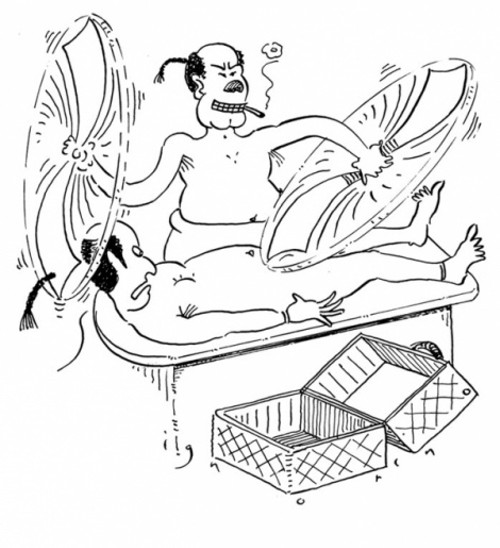Years ago I made the mistake of reading a book called The Journeyer by Gary Jennings, about the life and adventures of Marco Polo. If you’re not familiar with Jennings’ work, the synopsis is simple: sex, violence, history, sex, violence. Needless to say, I read it in about a day. Jennings writes of a torture practiced in the Orient of Polo’s time called “death by a thousand cuts.” Supposedly the grand poobah torturer would fill a container with 1,000 pieces of paper on which were written the names of body parts. He would then pick out one slip after another and cut, maim, or burn the assigned body part, keeping the victim alive until all 1,000 were used up. I’d forgotten about this until I heard the phrase in conversation recently. Was this really a torture practiced anywhere at any time? —Beer-is-Yummy, via the Straight Dope Message Board
Before this question can be answered, we need to scrape back certain dubious encrustations:
1. “Death by a thousand cuts” is strictly a Western expression—the Chinese term is lingchi, the origin and literal meaning of which is obscure. Three dozen cuts is more like it, although I’ve seen one account claiming especially iniquitous individuals wound up in 120 pieces, which I guess might require up to 119 cuts.
2. Other than in Jennings, I’ve never heard anything about a body-part job jar.
Those caveats having been offered, yes, death by numerous cuts was an accepted method of execution in China until 1905. The idea was to hack the condemned to pieces in public. But here’s the bit that slays me, so to speak: Western sniffs thought this was inhumane.
The story is told in a fascinating 2008 book, Death by a Thousand Cuts, by Timothy Brook et al. Lingchi was a punishment reserved for infamous crimes such as treason or parricide. The primary goal wasn’t prolonging the agony. Often the victim was drugged with opium; typically the executioner administered the coup de grace, a stab to the heart, soon after starting his work.
Instead, the point was to make an example of the poor bastard. It’s said the Chinese had a special horror of death by dismemberment, since it meant you’d show up mutilated in the afterlife. The condemned was trotted out into the marketplace and methodically butchered. The breasts were sliced off, and hunks of flesh were gouged out of the arms and thighs. After that the limbs were severed, and finally the head. The whole thing was over in maybe five minutes. Lesson for the assembled masses: don’t be bad.
Though reports of painful Chinese punishments had long circulated in the West, lingchi didn’t become notorious outside China until the publication of drawings and eventually photographs of lingchi in progress in the 19th and early 20th centuries. The grisly images confirmed outsiders’ belief in China’s exceptional cruelty, justifying Western exploitation.
Which is pretty nervy when you think about it. Lingchi isn’t far removed from drawing and quartering (nonfatal hanging, then castrating and disemboweling the condemned while still alive, then beheading followed by hacking or tearing the body into four pieces), which was the statutory punishment for men convicted of treason in England until 1867. The garrote (strangulation by tightening a metal band around the neck, sometimes also involving a sharpened screw that pierced the spine) was the prescribed method of execution in Spain until 1973; U.S. authorities used it in the Philippines until 1902. The Chinese were appalled by the British practice of brutally flogging soldiers and sailors for minor offenses.
Forces commanded by King Leopold II of Belgium, who ran what’s now the Democratic Republic of the Congo as his personal forced-labor camp until 1908, murdered perhaps 10 million Africans as punishment for not producing enough rubber and ivory. They routinely chopped off the hands of the dead, and often the living, as proof they hadn’t wasted their bullets.
Criminals were publicly hanged in the U.K. until 1868, in the United States until 1936. In “short drop” hanging, the standard method until the mid-19th century, the condemned typically took 10 to 20 minutes to die of strangulation. Longer drops were later used, to break the neck and induce immediate unconsciousness. However, sometimes the distance was miscalculated and the victim—sorry, criminal—was decapitated. Prisoners put to death in the electric chair, the United States’ best-known contribution to execution technology, have sometimes caught fire or required repeated jolts; admittedly these were mistakes, but even now the prescribed procedure is to apply the current, then wait a bit and see if the condemned is dead.
Most of this is ancient history, though. China has now achieved global parity in the corrective methods department. True, it still puts people to death, a practice abolished in most countries. But it has plenty of company among the great, or anyway most populous, nations of the earth, including India, Indonesia, and of course the non-criminal-coddling United States.
Subscribe to the Straight Dope podcast—search for “straight dope” in the iTunes Store. Send questions to Cecil via StraightDope.com or write him at the Chicago Reader, 11 E. Illinois, Chicago 60611.
More by Cecil Adams
-
This Is the End, My Friend
This week's Straight Dope marks the last appearance of the column as the Teeming Millions have known it for the past 45 years.
- Jul 11, 2018
-
Do Brain Supplements Do Anything?
Brain Drain
- Jul 4, 2018
-
Is flying really worse for the environment than driving?
Planes and Trains
- Jun 27, 2018
- More »




